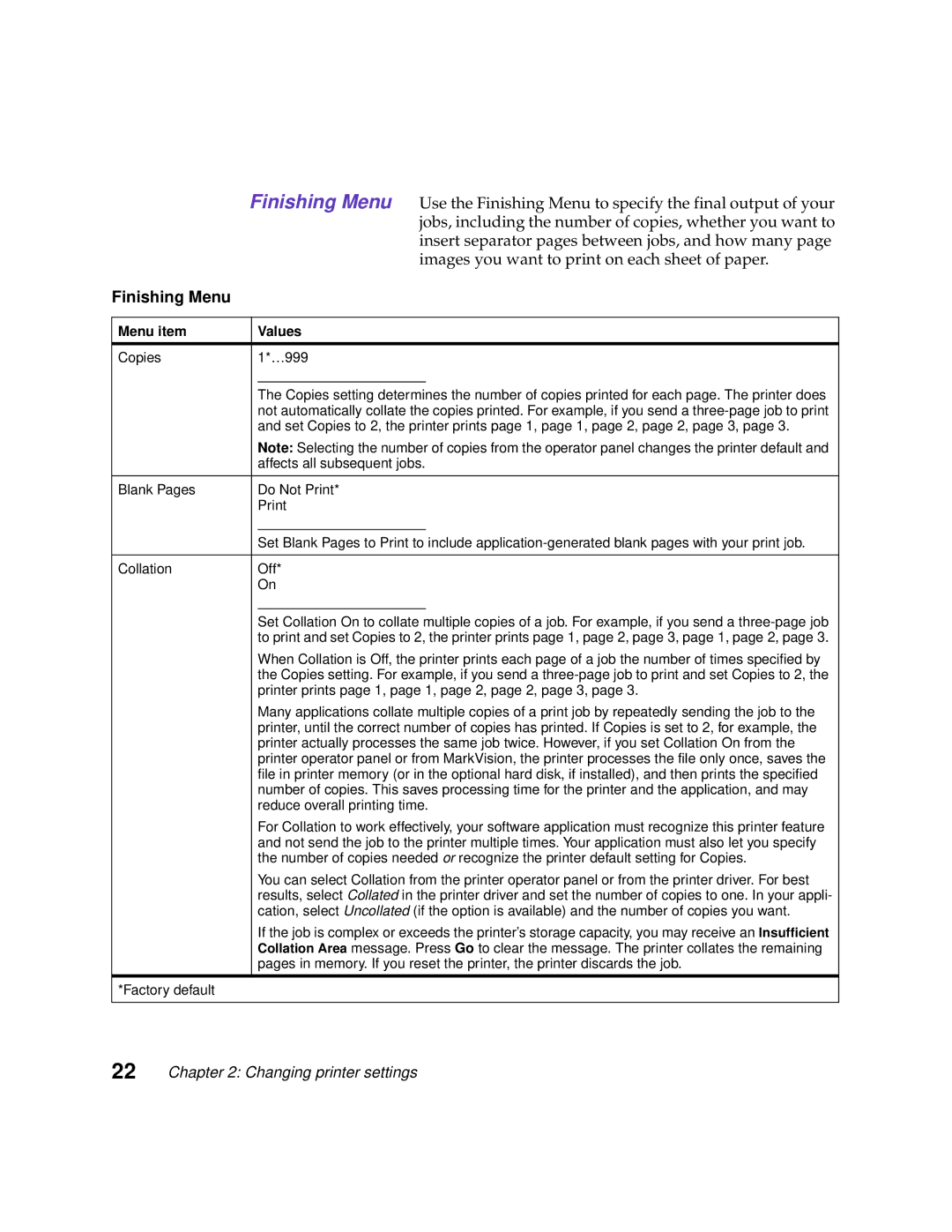| Finishing Menu | Use the Finishing Menu to specify the final output of your | |||
|
|
|
| jobs, including the number of copies, whether you want to | |
|
|
|
| insert separator pages between jobs, and how many page | |
|
|
|
| images you want to print on each sheet of paper. | |
Finishing Menu |
|
|
|
|
|
|
|
|
|
|
|
Menu item |
|
| Values |
|
|
|
|
|
|
|
|
Copies |
|
| 1*…999 |
|
|
|
|
|
|
| |
|
|
| The Copies setting determines the number of copies printed for each page. The printer does | ||
|
|
| not automatically collate the copies printed. For example, if you send a | ||
|
|
| and set Copies to 2, the printer prints page 1, page 1, page 2, page 2, page 3, page 3. | ||
|
|
| Note: Selecting the number of copies from the operator panel changes the printer default and | ||
|
|
| affects all subsequent jobs. | ||
|
|
|
|
|
|
Blank Pages |
|
| Do Not Print* |
|
|
|
|
|
|
| |
|
|
|
|
| |
|
|
| Set Blank Pages to Print to include | ||
|
|
|
|
| |
Collation |
| Off* |
|
| |
|
|
| On |
|
|
|
|
|
|
| |
|
|
| Set Collation On to collate multiple copies of a job. For example, if you send a | ||
|
|
| to print and set Copies to 2, the printer prints page 1, page 2, page 3, page 1, page 2, page 3. | ||
|
|
| When Collation is Off, the printer prints each page of a job the number of times specified by | ||
|
|
| the Copies setting. For example, if you send a | ||
|
|
| printer prints page 1, page 1, page 2, page 2, page 3, page 3. | ||
|
|
| Many applications collate multiple copies of a print job by repeatedly sending the job to the | ||
|
|
| printer, until the correct number of copies has printed. If Copies is set to 2, for example, the | ||
|
|
| printer actually processes the same job twice. However, if you set Collation On from the | ||
|
|
| printer operator panel or from MarkVision, the printer processes the file only once, saves the | ||
|
|
| file in printer memory (or in the optional hard disk, if installed), and then prints the specified | ||
|
|
| number of copies. This saves processing time for the printer and the application, and may | ||
|
|
| reduce overall printing time. | ||
|
|
| For Collation to work effectively, your software application must recognize this printer feature | ||
|
|
| and not send the job to the printer multiple times. Your application must also let you specify | ||
|
|
| the number of copies needed or recognize the printer default setting for Copies. | ||
|
|
| You can select Collation from the printer operator panel or from the printer driver. For best | ||
|
|
| results, select Collated in the printer driver and set the number of copies to one. In your appli- | ||
|
|
| cation, select Uncollated (if the option is available) and the number of copies you want. | ||
|
|
| If the job is complex or exceeds the printer’s storage capacity, you may receive an Insufficient | ||
|
| Collation Area message. Press Go to clear the message. The printer collates the remaining | |||
|
|
| pages in memory. If you reset the printer, the printer discards the job. | ||
|
|
|
|
|
|
*Factory default |
|
|
|
|
|
|
|
|
|
|
|
22 Chapter 2: Changing printer settings
